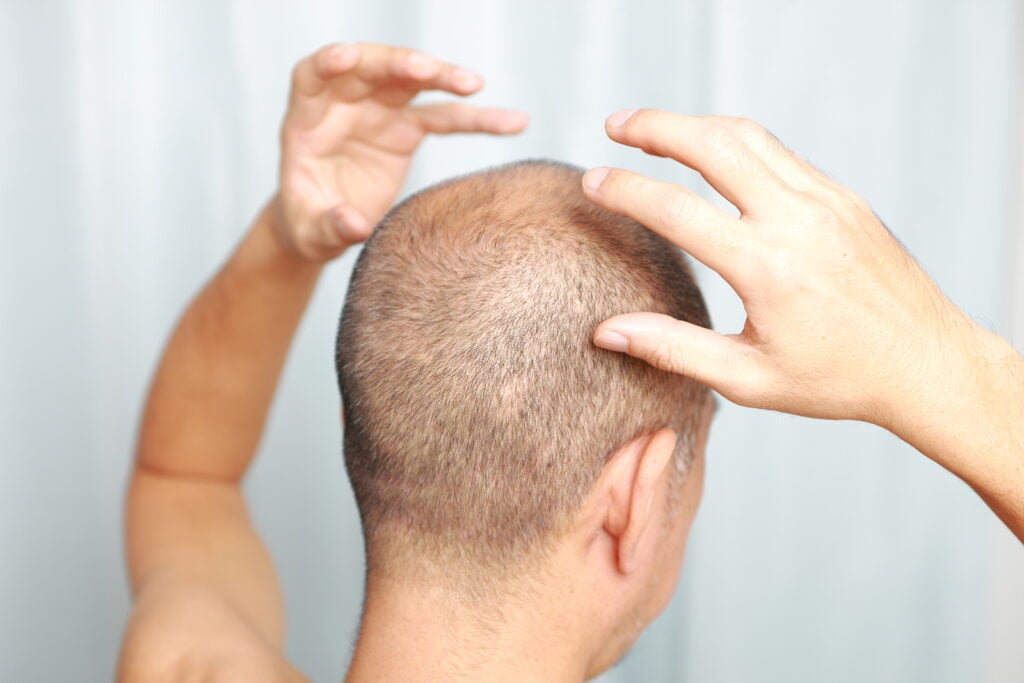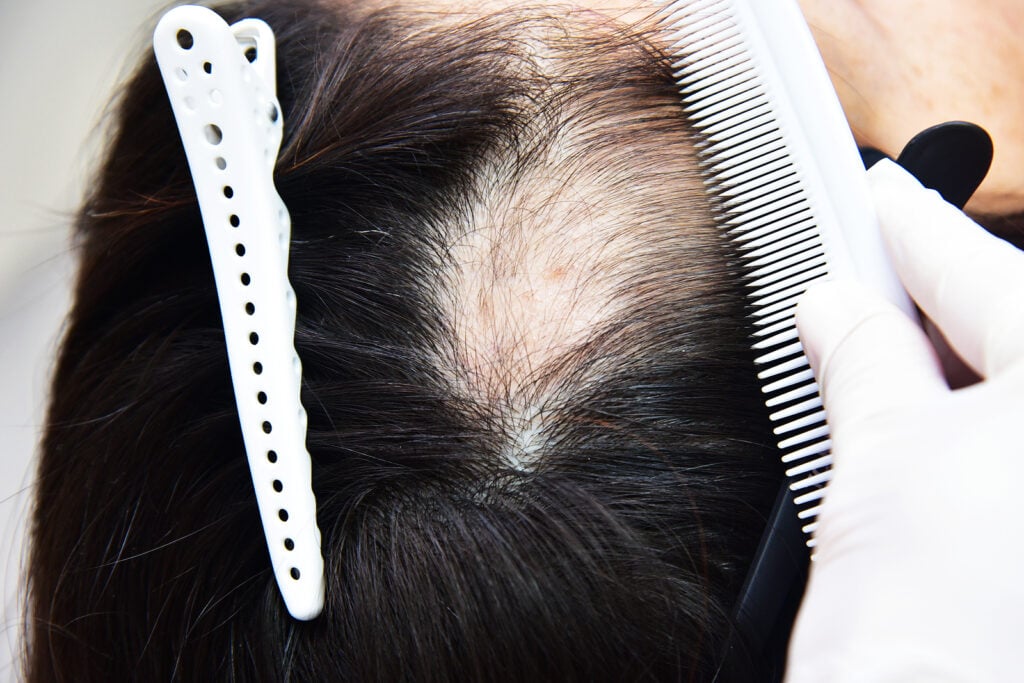
Artificial Hair Transplant: How It Works Today
When people hear artificial hair transplants, they think about the unnatural-looking plugs from the 80s and 90s. These early techniques in the hair transplant industry did not provide satisfactory results for many patients and have coloured some people’s perceptions of the treatment as a whole.
Today, synthetic hair transplants offer more natural results through techniques like follicular unit transplantation (FUT) and follicular unit extraction (FUE). These modern approaches harvest individual follicular units for seamless transplantation, providing a more appealing solution for those seeking to restore their hair and confidence. Let’s explore how synthetic hair transplants have evolved over time.
Summary
- What Is an Artificial Hair Transplant?
- Artificial Hair Transplant Procedure
- Who Is Eligible for an Artificial Hair Transplant?
- What Are the Advantages and Disadvantages?
- Risks and Side Effects of an Artificial Hair Transplant
- Real Hair Transplant vs Artificial Hair Transplant
- Explore Your Hair Transplant Options
What Is an Artificial Hair Transplant?
An artificial hair transplant, also known as a synthetic hair transplant, involves implanting artificial fibres or materials into the scalp to mimic the appearance of natural hair.
Unlike traditional hair transplants, which use real hair follicles harvested from the patient’s scalp, artificial hair transplants utilise synthetic materials such as medical-grade fibres or polymers. These materials are designed to resemble natural hair in texture, colour, and thickness.
Though slightly more invasive than standard transplants, artificial options offer alternatives for those with limited donor hair.
History of artificial hair transplants
Artificial hair transplants have undergone significant evolution since the conspicuous plugs of the 80s and 90s, which left many dissatisfied. The procedure faced controversy and a temporary ban in the US due to unsatisfactory results and safety concerns.
However, advancements in techniques like follicular unit transplantation (FUT) and follicular unit extraction (FUE) have transformed the field. In fact, modern artificial hair transplants offer more natural-looking results with minimal scarring, restoring confidence in the procedure, and making it a viable option for those seeking to address hair loss effectively.
Artificial Hair Transplant Procedure

Performing an artificial hair transplant is more invasive than a natural hair transplant, as synthetic fibres are being implanted deeper into the scalp. The procedure for a synthetic hair transplant typically includes:
- Scalp anaesthesia: Your scalp is numbed to minimise discomfort.
- Synthetic hair implantation: Surgeons use a hook to individually insert synthetic hairs under the scalp until the desired density is achieved.
- Depth of implantation: Synthetic hairs go deeper into the scalp than traditional procedures, relying on firm embedding to prevent excessive shedding.
- Maintenance: Regular top-up treatments are needed since some fibres may eventually come away during brushing. Unlike permanent transplants, ongoing sessions are required for sustained results.
Who Is Eligible for an Artificial Hair Transplant?
Artificial hair transplants provide a viable solution for individuals lacking sufficient or healthy donor hairs for traditional transplant methods. This includes those with severe pattern baldness, where traditional donor areas may be depleted, and individuals with retrograde alopecia, characterised by hair loss extending beyond the typical balding areas.
Similarly, scarring alopecia patients, whose donor areas are compromised due to scarring, find artificial transplants beneficial.
These innovative procedures offer hope for those previously deemed ineligible for hair restoration, broadening the scope of options for those seeking to regain their hair and confidence.
What Are the Advantages and Disadvantages?

The more modern artificial hair transplants provide an option for those who do not have sufficient or healthy donor hairs. And since there’s no extraction process, studies show that it usually takes less time than a real hair transplant.
Advantages
A significant advantage of the procedure lies in the fact that artificial hairs provide a more deeply embedded alternative to natural hair transplants, reaching further into the scalp. This depth ensures a natural appearance and delivers instant results, compared to the extended waiting period of up to 18 months typically associated with natural hair procedures. With artificial hair transplants, you can also expect to see results between 20–30 days.
Now artificial hair fibres can be created to suit your individual hair type, style, density, and colour. They can be tailored to different textures, such as curly, afro and straight to create a natural appearance and provide aesthetic results.
Disadvantages
While the procedure is much safer than it used to be, it is more invasive than a traditional hair transplant and requires further aftercare precautions. The procedure is more of an implant than a transplant as it uses foreign bodies as donor hairs and not your own follicles. Due to this, some people may not be considered for an artificial transplant. These include those who have scalp diseases and autoimmune conditions.
Despite technological advancements, synthetic hairs in artificial transplants typically last only 7–8 years, with an annual shedding rate of approximately 10%, requiring periodic maintenance. There are also further restrictions, such as the limitation of styling and dyeing options.
Risks and Side Effects of an Artificial Hair Transplant
Artificial hair transplants, while offering a solution for hair loss, come with potential risks and side effects. These may include infection, scarring, and allergic reactions to synthetic materials.
Two cases reported infection when individuals skipped tolerance tests before treatment. With a 95-98% success rate, around 2% required fibre extraction due to inflammation or infection. Because of this, it is essential to receive a tolerance test before the surgery.
Real Hair Transplant vs Artificial Hair Transplant
Real hair transplants involve harvesting and transplanting natural hair follicles from donor to recipient areas, providing permanent results with natural-looking hair growth.
In contrast, artificial hair transplants use synthetic materials implanted into the scalp, offering a quick solution for those lacking sufficient donor hair but requiring ongoing maintenance for sustained results.
Explore Your Hair Transplant Options
Artificial hair transplants have come a long way in the last 40 years to become safer and more effective. The technology available now allows for more natural-looking results for those suffering from hair loss. Particularly for those who may not be a candidate for a natural hair transplant.
If you are a match for a traditional hair transplant, there are many more advantages compared to an artificial hair transplant, however.
If you’d like to find out more about hair restoration treatments and if you are a suitable candidate, contact one of our experts today. We can provide you with a free consultation in order to help you start your journey towards full hair today.


